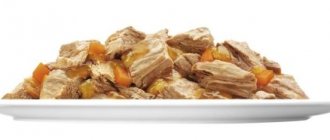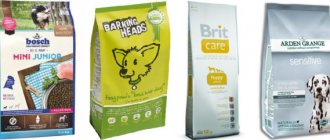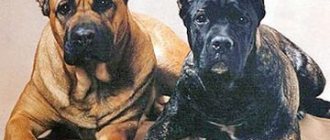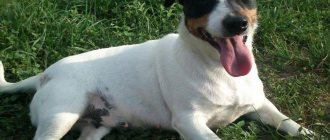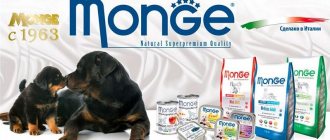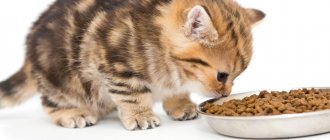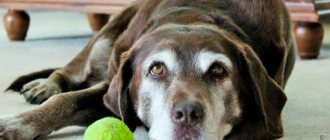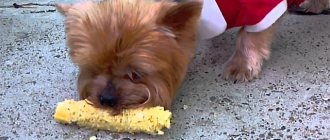As the animal ages, it becomes less active and eats and sleeps more. This has nothing to do with laziness. The main reason is the natural slowdown of metabolism. An older animal begins to gain weight while maintaining its previous diet. In this regard, veterinary experts strongly recommend gradually changing your pet’s diet, reducing the total calorie content of the diet without losing useful and nutritious elements.
Manufacturers of ready-made kibble and wet food have developed diets taking into account the basic needs of an old dog. It is important not only to reduce the caloric content of such a diet, but also to maintain a balance of nutrients such as fatty acids and antioxidants. All this is necessary for the successful long-term functioning of the immune system and the maintenance of the joints of an aging dog.
Diet for old dogs
It is always necessary to remember about the tendency of older dogs to obesity due to low mobility. Older animals have a harder time digesting certain types of food (see below for more details).
Dry food
Every good manufacturer makes products for older dogs. We have prepared a short review of the best premium/super-premium products:
Advance
Ready-made food for dogs of the Advance brand belongs to the super-premium class. The advantage of the food is that there are separate advance dry diets for older dogs of small and large breeds. We will review Advance Dog Mini Senior food for small breed dogs, respectively.
Ingredients: chicken (16%), corn gluten (1), poultry proteins, rice, corn (2) and corn flour (3), animal proteins, corn bran (4), potassium chloride, food additive E450 (! ), chondroitin sulfate (prevention of joint diseases).
Monge
The Monge brand produces dry food for pets. Production facilities are located in Italy. As an example, let's take Mini Senior, for oldies of small breeds.
Chicken is listed in the 1st place in the composition. Carbohydrates: rice, oats, beets, corn. Contains animal fats, yeast.
Acana
One of the best brands of dry pet food. High-quality grain-free Acana food belongs to the holistic class. A specialized diet ACANA SENIOR DOG has been prepared for older pets. Suitable for all breeds.
Main ingredients: chicken, flounder, eggs, vegetables/fruits/greens.
Brit premium
Good premium products. The line includes a separate diet for older dogs of different breeds. Consider Brit Premium Senior Smal & Medium for small and medium breeds, respectively.
Ingredients: the main source of protein is chicken (42%), carbohydrates include oats, wheat and corn, contains a small amount of fruit (dried apples), cartilage. The food also contains vitamins and nutritional supplements.
1st choice
First Choice is a super-premium dog food. A distinctive feature of Canadian products is quality. As an example, let's take Fest Choice food for older dogs of all breeds (SENIOR ALL BREED).
Ingredients include: lamb/herring flour, rice, barley, vegetables, liver, etc. As a big plus, we can note an impressive number of nutritional supplements that are needed to maintain bones/muscles/metabolism in older dogs.
Eukanuba
Products from a domestic manufacturer. Eukanuba for senior dogs with lamb and rice is suitable for pets over 7 years old (for medium breeds, for large breeds - from 6, giant - from 5).
The contents of the granules include dehydrated poultry and lamb proteins. Next are rice, millet, corn, barley. Contains animal fats and flavoring additives.
Go!
GO brand products are all-natural grain-free pet food. Older dogs are offered Go Senior Recipe Chicken,Turkey + Duck food with 4 types of meat at once.
The protein base consists of chopped chicken, turkey, and salmon. Also includes fillets of birds and fish of these species, eggs, apples and other fruits. The granules are rich in minerals and vitamin supplements.
Now fresh
Nau Fresh products belong to the holistic class. The grain-free diet, designed for dogs over 7 years of age, contains a reduced amount of calories.
The source of protein is turkey and salmon fillet. Valuable carbohydrates are found in numerous vegetables and fruits.
Wet food
The production of wet food for older animals is surprisingly stingy. If you prefer soft store-bought food, then choose regular bags (cans) for adult animals. Before purchasing, check the composition for the presence of harmful components.
At what age does a pet reach old age?
A dog's old age does not occur immediately: irreversible processes in his body occur gradually. Veterinarians classify those pets that have reached the age of 7-8 years as elderly. In addition, the onset of old age is influenced by the size of the dog and its breed:
- In dwarf and small breeds, this period begins at 9-10 years.
- In medium and large breeds, old age occurs at 7-8 years
- Giant dogs age from 6-7 years.
It is not difficult for even the most attentive owner to notice signs of changes. Chronic diseases, loss of motor activity, decreased visual acuity and decreased appetite are signs that your pet is aging. At this moment, the owner begins to think about what to feed his old dog.
Minerals and vitamins
Vitamins are the most important part of food for older dogs. Over time, the body completely stops producing certain substances, which can lead to illness and premature death of the animal. However, vitamins and supplements should be treated with caution.
For example, if you feed an animal with super-premium or holistic products, there should already be a sufficient amount of additives and there is no need for additional vitamins. With a straight woman the situation is a little different.
What supplements should be in food for aging dogs?
Useful components needed in dry food:
- Vitamin E (aka α-tocopherol) . Safely protects the product from spoilage, prevents the destruction of fortified supplements, and helps absorb other vitamins. Protects cells from damage and prevents the development of tumors.
- Taurine . An amino acid essential for vision and heart health.
- Choline chloride . Contains vitamin B4, promotes the breakdown of fats. Prevents some diseases associated with poor metabolism. The animal's body produces little choline chloride, so it is a very important additive in food.
- Omega-3 . Prevents the development of arthritis, which especially affects aging large breed dogs.
- Biotin and L-carnitine . Biotin improves metabolism and breakdown of fatty acids. L-carnitine, in turn, prevents the development of obesity in your pet.
But Omega-6 will not bring much benefit to older animals.
Natural vitamin supplement
Unlike dry food, a dog cannot get everything it needs on natural food. Today there is a huge variety of veterinary products that will provide the animal with all its needs. The main thing is to consult with your veterinarian before giving your pet any supplements.
To increase certain individual components in the animal's body, include foods that contain them in the diet. For example, a little cottage cheese to maintain calcium. Before doing this, carefully read the list of prohibited products.
Can dogs take human vitamins?
Human vitamins are designed for people. Dogs are not allowed to have them under any circumstances.
Summing up
- Old age cannot be cured. However, you can extend your pet’s life and improve its quality, including with the help of a proper diet.
- The diet of an old dog should be based on proteins and fats of animal origin.
- Special food is not necessary. It is much more important that the product used is of high quality and suitable for the pet.
If you still have questions about feeding old dogs, ask our consultant in the chat. We will give competent answers and help you choose a ready-made diet.
Natural food
An ordinary natural meal is porridge with meat, often with the addition of some vegetables (carrots, etc.) and feeding in the form of eggs. Aging dogs have their own needs and problems, so in the last stages of her life, nutrition will have to be slightly reconsidered:
- more fiber (vegetables, bran, vegetable oil) to prevent constipation;
- sometimes the meat needs to be ground so that a dog with problem teeth eats comfortably;
- A complex of vitamins for dogs will “save” you from joint problems.
Establishing a regime
Building a daily routine begins after the moved animal has completely settled into the new place and gets used to the surrounding environment. This usually happens one to two weeks after the move.
Having a clear schedule makes life somewhat more difficult for the owner, but it also has advantages:
- Strict alternation of nutrition and physical activity eliminates the possibility of obesity and allows you to maintain good physical shape.
- Just make a menu in advance and make sure you get all the products you need for a healthy life. This is especially true for natural pets.
- It is easier to control natural urges in puppies. You know exactly when the animal will need a walk to perform its toilet duties, which means fewer unpleasant surprises await you.
- A clear routine can save lives. As soon as the pet remembers when it is fed daily, it stops picking up all the food available to it on a walk, because it knows that it will definitely be fed after a while. This means that the chance of being poisoned by something spoiled or deliberately scattered by dog hunters drops sharply.
- Attempts to bite and constantly beg for food from others disappear. This habit is found either in very spoiled dogs or in children who are gradually switching to fewer meals. But over time, the animal gets rid of this habit, which means the threat of gaining dangerous weight also decreases.
A clear arrangement of a pet’s daily life schedule depends only on the desire and capabilities of the owner. There are several rules that will make your dog’s life more comfortable and will help you carefully weave new responsibilities into a person’s usual rhythm of life:
- Analyze your life cycle and determine once and for all when is the best time to feed. Keep in mind that a puppy and a pregnant bitch require more feedings than an adult dog during a normal period.
- When deciding at what time you will provide food, consider physiological needs . The dog will want to relieve itself 20-30 minutes after feeding, and will also need a walk after 6-8 hours, provided that the digestive process is normal.
- As soon as the animal matures (usually this happens by the age of 2 years or a little earlier for representatives of small breeds), he will learn to tolerate several hours, but it is still better to accustom him and yourself to a walk immediately after breakfast, because pregnant, sick and old dogs cannot be tolerated. can, which means that when the status changes to a similar one, the pet will experience psychological discomfort due to its behavior.
- Accustom to a clear daily routine gradually and do not change it. Walking and feeding should be timed from the first weeks of the dog's stay in the house. However, the dog itself will get used to the established rules only after 6-7 weeks of observing them. If you yourself regularly break the routine, the animal will never be able to get into the rhythm.
What not to feed
The prohibitions for older pets are approximately the same as for young ones. You cannot give:
- smoked/fatty/fried/marinated/canned foods;
- bread, pasta;
- sugar in any form, sweeteners;
- mushrooms, beans;
- onion;
- hollow bones, boiled bones.
The list goes on and on. In order not to get lost, remember one rule: if food is considered unhealthy and harmful to humans, then 100% of it cannot be given to an animal.
It is not recommended to feed pets (of any age) food/natural food based on wheat or corn porridge. These are practically empty calories that provide little benefit to the animal’s body.
What you should absolutely not give
A dog, whether young or aging, should not be given table scraps. Old dogs need to be fed correctly. The following products are completely prohibited:
- fish, chicken, tubular bones;
- spicy/smoked/pickled food;
- alcohol, sweets;
- yeast baked goods;
- coffee Tea;
- unheat-treated river fish;
- milk;
- fresh eggs;
- persimmons, plums, peaches;
- currants, raisins, grapes;
- pineapple, kiwi, citrus fruits;
- avocado;
- raw cabbage;
- potatoes in any form;
- onion garlic;
- fruit seeds.
The range of industrial feeds is varied. Finding a product that meets the needs of an older dog is not difficult. But if the owner prefers to prepare food for the pet on his own, then the recommendations of veterinarians must be strictly followed. Food should not just be tasty, but as healthy as possible.
Briefly about the main thing
Be responsible when it comes to feeding your older dog. At this age, animals have poor health, which must be constantly maintained. If you feed natural food, make sure that your pet receives a sufficient amount of minerals and trace elements. But it will be better to feed dry, which one is up to you. Briefly about each product described above:
- 1st choice: good quality food with excellent composition. If you have the opportunity, definitely take it.
- Advance: not the most expensive food, but its composition is far from the best. Contains a lot of cheap carbohydrates in the form of corn and unwanted food additives. One of the advantages is an acceptable amount of vitamins and nutritional supplements.
- Brit premium: the composition of the feed is acceptable, the price matches.
- Eukanuba: the only positive side to note is the cost; the composition could have been better. Indistinct proteins are in the first 2 places, a lot of unnecessary carbohydrates.
- Go: the food definitely gets the best ratings, the price justifies itself. The disadvantages include increased allergenicity due to different types of meat and fish in the composition.
- Acana: There is no point in singing the praises of Acana products, since the brand has long established itself as one of the best on the market.
- Monge: good Italian products. Contains some cheap carbohydrates, but not critical.
- Now fresh: natural composition, rich in healthy nutritional supplements. We definitely recommend it.
Veterinarian advice
Experienced veterinarians advise owners not to feed their aging pets cheap food. An acceptable option for them is holistic or super premium food. When deciding to feed your dog natural food, you need to take into account that preparing the diet is a labor-intensive task that will require time, effort and attention from the owner. Among the best ready-made diets, experts highlight the brands Acana, Monge, Brit, Now.
What is the best way to walk your dog, how to stop pulling on the leash, how to treat your paws and what equipment you will need
Additionally, you should monitor the dog’s weight, encourage moderate physical activity, and regularly come for preventive examinations.
Feeding
What does proper feeding include? The main thing to remember is that your dog’s health depends not only on what you feed it, but also how often. Compliance with the norm helps your pet receive the necessary nutrients, avoiding their excess.
Why is overfeeding dangerous?
- disrupts the functioning of internal organs and systems;
- causes obesity;
- shortens life expectancy.
It doesn’t matter what the dog eats – dry food or natural food. A complete diet should be based on only high-quality products. The pet must receive vitamins, minerals, microelements in order to feel full of strength, energy, easily withstand stress, and cope with viruses and infections.
If the dog eats only dry food, then calculating the feeding rate is not difficult. The manufacturer provides information in the form of a convenient table directly on the packaging. After studying it, the owner will be able to determine the daily limit for his furry.
If the owner is against dry food and prefers natural nutrition, it is more difficult to correctly determine the required amount of food and the number of feedings. The owner must consider:
- weight;
- activity, frequency of walks;
- breed;
- health indicators;
- the correct ratio of meat, dairy products, vegetables, cereals, taking into account the content of vitamins and minerals in them.
Proper feeding is the prevention of many diseases. Therefore, there is no need to be lenient about this part of care.
There is no nutritional plan that is equally correct for all breeds. The norm is calculated strictly for each dog. If the owner cannot cope with the calculations himself, he is recommended to contact a veterinarian. The specialist will create a nutrition plan that will be tailored to a specific dog. The service is paid.
Serving sizes
The amount of food that needs to be given to the dog at one feeding is calculated individually. What should you consider when determining your serving size?
- breed;
- weight;
- age;
- metabolism;
- chronic diseases;
- activity.
The weight of a serving of dry and natural food is different.
| Weight | Daily intake of dry food |
| 1-5 kg. | 60-140 g. |
| 5-10 kg. | 140-200 g. |
| 10-15 kg. | 200-265 g. |
| 15-20 kg. | 265-330 g. |
| 20-25 kg. | 330-385 g. |
| 25-30 kg. | 385-450 g. |
| 30-40 kg. | 450-550 g. |
| 40-50 kg. | 550-650 g. |
| 50-60 kg. | 650-750 g. |
| 60-70 kg. | 750-835 |
If the dog is active and receives daily physical activity, the portion weight is slightly increased. On the contrary, when the pet is low in activity, the amount of feeding is slightly reduced.
When feeding natural food, the serving volume is calculated based on the animal’s body weight. For example, if you need to determine how much a dog weighing 50 kilograms will eat, you need to make simple calculations:
3.5% of 50 – 50 x 3.5\100 = 1.75
The resulting portion weight is divided into at least 2 doses.
If you keep dogs of the same breed and age in your home, they may still need different amounts of food. For example, one pet may be more active, another - passive.
How much water do you need
On average, an adult dog needs to drink up to two to three liters of water per day. A given pet's fluid needs can vary greatly depending on factors:
- type of food (dry food or natural food) – if the dog eats commercial food, it will need more water;
- size – the smaller the dog, the more often it will approach the water bowl;
- physical activity – your pet needs to drink during walks and physical activity;
- ambient temperature - in hot weather the pet will feel thirsty, the volume of fluid consumed these days will increase significantly.
The dog should consume 40 ml. water per kilogram of your weight. Puppies drink several times more often. However, with age, the need for fluid decreases.
Your furry cat should always have access to clean, drinking water. Dehydration leads to serious health problems. Give preference to filtered water. It is better to avoid drinking from the tap. However, remember that extreme thirst is not normal. If the dog does not leave the water bowl, this is a reason to contact the veterinarian. Complete refusal of water is also an indication for visiting a doctor.
Additional Additives
A nutritional supplement is a concentrated ingredient added to your pet's food to improve its health. Additives are used as auxiliaries that are needed for the prevention and treatment of diseases:
- allergy;
- dysfunction of the joints;
- sensitivity of the gastrointestinal tract;
- skin itching, hair loss;
- tooth loss;
- inflammatory processes in the body;
- heart failure;
- renal failure;
- urolithiasis disease;
- other.
The use of special additives is only relevant on the recommendation of a veterinarian. Self-selection is guaranteed to harm the health of your furry friend.
Dogs that eat a balanced dry food receive the vitamins and minerals needed to maintain normal health. They have no need for supplements. The opposite situation is sometimes observed in pets whose diet includes natural products. These animals can sometimes have a deficiency of certain elements (antioxidants, acids), since the owners are not always able to create their own diet.
You can feed your dog some vegetables and unsweetened fruits. For example, apples, carrots, cucumbers.
Pregnant bitch
During pregnancy, you will have to gradually change your usual regimen, increasing not only the frequency of meals, but also the size of portions. For a pregnant bitch, it is no longer enough to eat only 2 times a day. In addition, she needs significantly more nutrients and vitamins than before. However, you should not start breastfeeding immediately after conception. The third meal appears no earlier than 2 months of pregnancy, and the dog will eat 4 times only towards the end of the term.
It is very important to feed your pet with additional supplements at this time so that the cubs can develop fully and the mother’s health is not caused irreparable harm.
Puppy
Depending on age, the number of meals will vary from 6 times every 2 months, to an adult schedule with breakfast and dinner by 10-12 months, depending on the breed. When drawing up a schedule, it is necessary to take into account not only age and times, but also the time intervals between meals. By reducing feedings and increasing portion sizes, you try to maintain the same time intervals.
Puppies need to be fed:
| Age in months | Number of feedings per day | Approximate time |
| 1-2 | 6 | IN 7, 10, 13, 16, 19, 22 |
| 2-3 | 5 | IN 7, 10, 14, 18, 22 |
| 3-4 | 4 | IN 7, 12, 17, 22 |
| 4-6 | 3-4 | IN 7, 12, 17, 22 |
| 6-10 | 3 | IN 7, 13 21 |
| from 10 | 2 | IN 7, 21 |
Broccoli.
Cruciferous vegetables such as broccoli, cabbage, cauliflower and Brussels sprouts will provide your dog with antioxidants and other nutrients that help prevent cancer. The quantity is limited if they lead to increased gas formation. These vegetables are best served cooked because raw they can suppress thyroid function if fed in large quantities.
